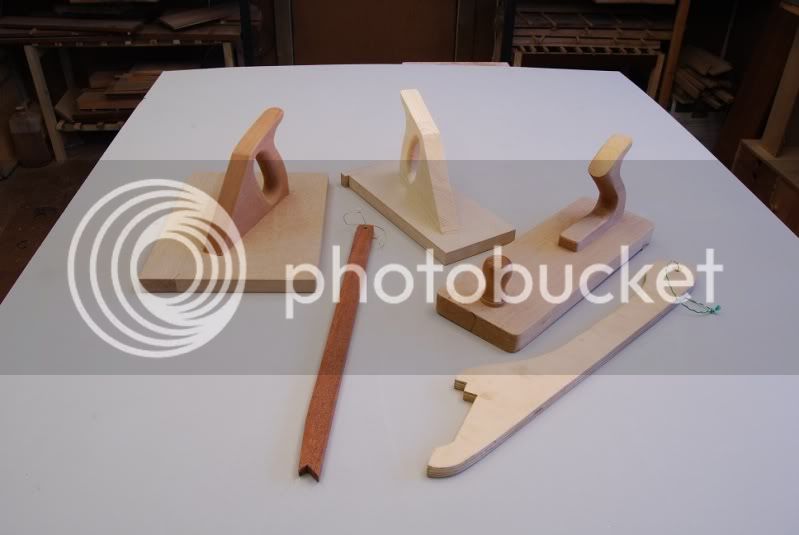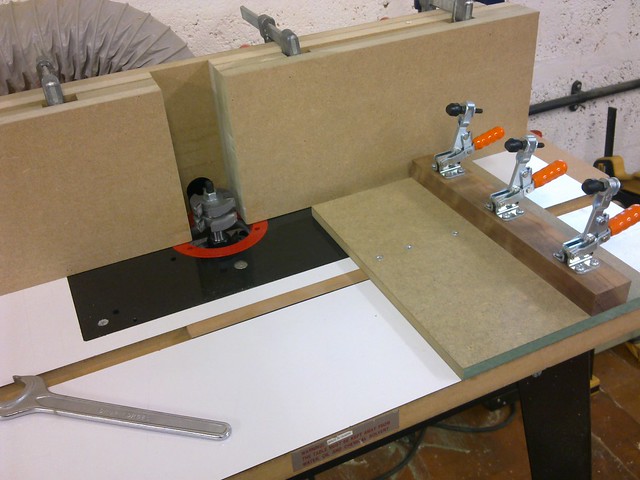devonwoody
Established Member
Well the slot is like having pound notes loose in your pocket or secured away in a wallet & back pocket with a button as well.
You get what you want.
You get what you want.

You're absolutely right Paul and as Bob9f said earlier, the lack of track was amply demonstrated to the assembled multitude at Wizer's bash a couple of years ago. I've got a couple of angled push pads, the one shown in the pic is for smaller stuff like rebates in picture frames and I have a larger, square one:paulm":2gnlp8lj said:Mr Ed":2gnlp8lj said:The thing you need the mitre slot for is cutting the scribed tenons on the ends of frame sections when doing cope and stick frame joinery. I you don't do that, then fair enough, but I can't imagine how else you'd do it without the slot.
Ed
Just use a push pad like Rob's running against the fence with the workpiece in front, if the push pad has 90 degree corners then it will work the same as a mitre gauge, or if you have a few to do you can make another simple sled (same principle) with a holddown on it for added safety and accuracy.
Running off the fence renders a track and mitre gauge redundant for anything I've ever wanted to do and saves having to set the fence parallel to the track as well as in the right position relative to the router bit which could be a bit of a fiddle.
Cheers, Paul

paulm":qlnkos5i said:Mr Ed":qlnkos5i said:The thing you need the mitre slot for is cutting the scribed tenons on the ends of frame sections when doing cope and stick frame joinery. I you don't do that, then fair enough, but I can't imagine how else you'd do it without the slot.
Ed
Just use a push pad like Rob's running against the fence with the workpiece in front, if the push pad has 90 degree corners then it will work the same as a mitre gauge, or if you have a few to do you can make another simple sled (same principle) with a holddown on it for added safety and accuracy.
Running off the fence renders a track and mitre gauge redundant for anything I've ever wanted to do and saves having to set the fence parallel to the track as well as in the right position relative to the router bit which could be a bit of a fiddle.
Cheers, Paul

Mr Ed":arv1i02j said:paulm":arv1i02j said:Mr Ed":arv1i02j said:The thing you need the mitre slot for is cutting the scribed tenons on the ends of frame sections when doing cope and stick frame joinery. I you don't do that, then fair enough, but I can't imagine how else you'd do it without the slot.
Ed
Just use a push pad like Rob's running against the fence with the workpiece in front, if the push pad has 90 degree corners then it will work the same as a mitre gauge, or if you have a few to do you can make another simple sled (same principle) with a holddown on it for added safety and accuracy.
Running off the fence renders a track and mitre gauge redundant for anything I've ever wanted to do and saves having to set the fence parallel to the track as well as in the right position relative to the router bit which could be a bit of a fiddle.
Cheers, Paul
Good luck with holding a component against a push pad and then running the end grain across the cutter - I wouldn't fancy it, plus you'd struggle to keep it square.
This is the sled I use;

This allows the fixture to miss the cutter as it stops short of the fence. If you run on the fence you need a big sacrificial piece to avoid damaging your fixture on the cutter.
Each to their own, but in my view the slot is essential.
Ed
Enter your email address to join: